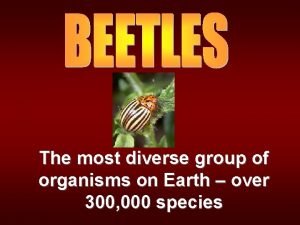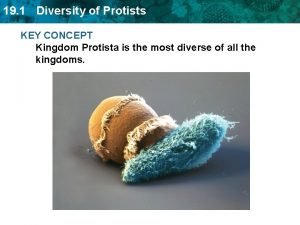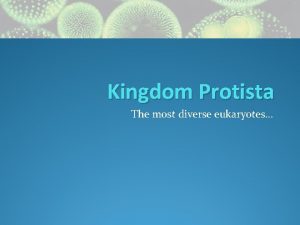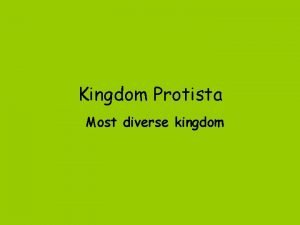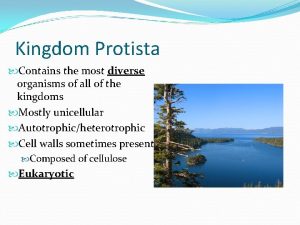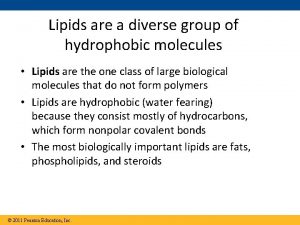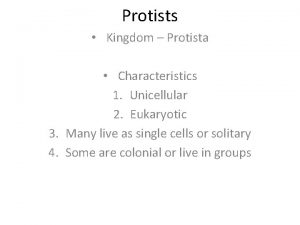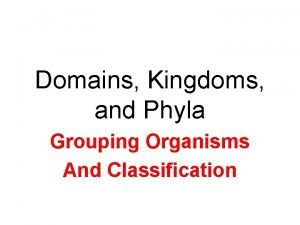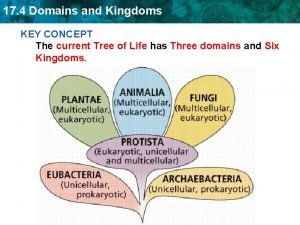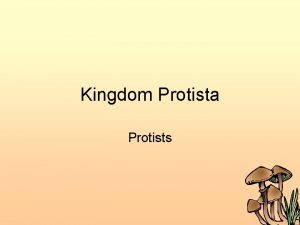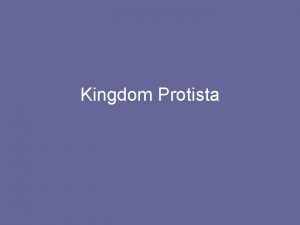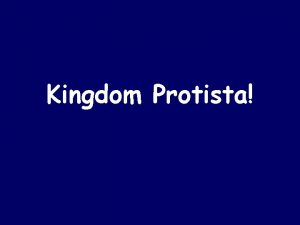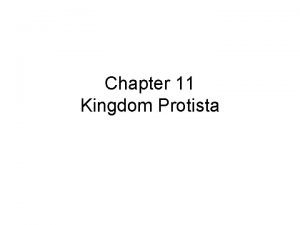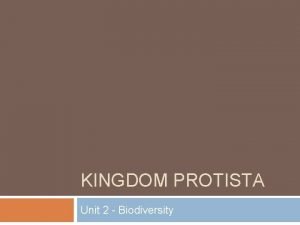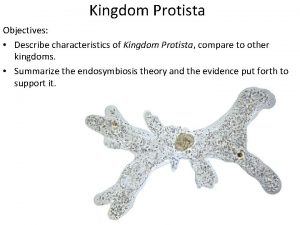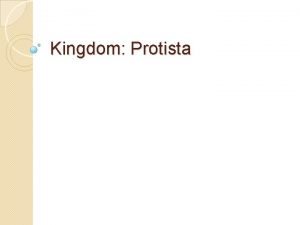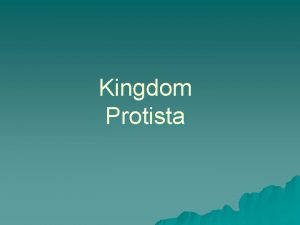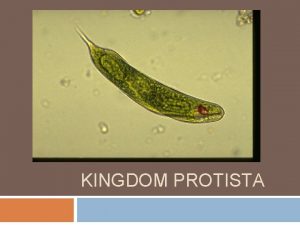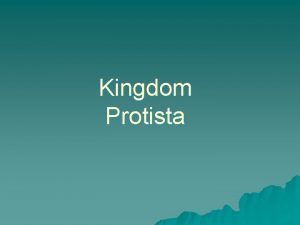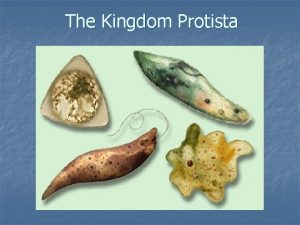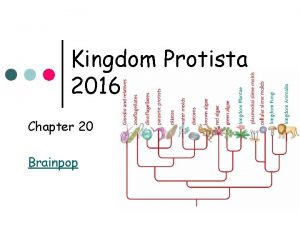Kingdom Protista Highly diverse group of organisms Size
















- Slides: 16

Kingdom Protista • Highly diverse group of organisms – Size range from 5 µm to several meters (kelp) – Defined more by what they aren’t – Nutrient/energy acquisition ranges from photosynthesis to predatory to detrivores – Important in many food webs • Provide link between bacteria and larger organisms library. thinkquest. org/ 12413/protist. html 1

Plant-like Protists • Contain chloroplasts • Representatives – Diatoms (right). • Diatomaceous earth = fossilized diatoms: abrasives and slug repellants. – Red, brown, yellow algae • Seaweed, source of agar – Dinoflagellates • Neurotoxins and red tide http: //www. bhikku. net/archives/03/img/diatoms. JPG www. enviroliteracy. org/ article. php/534. html 2

Fungus-like • Water molds • Slime molds Animal-like protists Capable of ingesting their food. Found among many different groups, so not good for taxonomy. http: //en. wikipedia. org/wiki/Slime_mold http: //ar. geocities. com/seti_argentina/estamos_solos/ameba. jpg 3

How to classify? • Cell ultrastructure and molecular analysis becoming the main methods used for classification. – Suggests that several kingdoms would be appropriate. – Alternative scheme, keep the kingdom Protista, classify protozoa into several phyla • Typical textbook: – 4 groups of protozoa – Algae – Slime molds – Water molds 4

5 http: //www. actionbioscience. org/evolution/figu res/dacksfig 1. gif

Protozoa • • • What are the characteristics of Protozoa? Unicellular eukaryotes Lack a cell wall Require moist environments (water, damp soil, etc) Great amounts of diversity – Locomotion: float, cilia, flagella, pseudopodia – Nutrition: chemoheterotrophs, photoautotrophs, either – Simple to complex life cycles, reproduction – Different cell organelles, some lack mitochondria 6

Some protozoal terminology 7 • Cyst: a resting stage similar to a spore with a thick wall and low level of metabolism. • Trophozoite: stage in life cycle during which the microbe is feeding and growing. • Merozoite: Small cells with a single nuclei produced during schizogony. – Large, multinucleated cell undergoes cytokinesis to produce multiple daughter cells (merozoites) • Cytoplasmic streaming. – Cytoskeleton aids extension of cell membrane

Classification of Protozoa • Alveolates – Ciliates – Apicomplexans – Dinoflagellates • Amoebae – Shelled and unshelled 8 • Euglenozoa – Ameobae – Euglenoids – Kinetoplastids • Archaezoa – Diplomonadida – Parabasala http: //www. jracademy. com/~mlechn er/archive 1999/paramecium. JPG

Protozoa: details and examples 9 • Alveolates • Possess alveoli: small membrane-bound cavities of unknown function (classification by ultrastructure) – Ciliates: move by cilia, short flagella-like appendages • Includes disease-causing Balantidium – Apicomplexans: have a complex of specialized organelles at the apices (corners, tips) of the cells • Generally have complex life cycles • Include Plasmodium (malaria), Toxoplasma (toxoplasmosis).

Apicomplexans Complex structure of organelles involved in infection. http: //cgdc 3. igmors. u-psud. fr/microbiologie/apicomplexans_fichiers/image 002. jpg 10

Alveolates continued 11 – Dinoflagellates • Large group of plantlike protozoa, have photosynthetic pigments (chlorophylls), cellulosic cell walls, store sugars as starch. • RNA sequences show relationship to other aveolates, not to plants. • Large portion of fresh water and marine plankton • Some encased in silica • Some bioluminescent or produce red pigments • Some produce dangerous neurotoxins

Amoebae • Amoebae have 2 main characteristics – Move and feed using pseudopodia • Cytoskeleton aids extension of cell membrane, cytoplasmic streaming. – Lack mitochondria • Some have loose shells; some form cysts. – Fossilized shells major component in some limestones. • Some “ameobae” are classified in another group. • Entamoeba: example of disease-causing amoeba. 12

Euglenozoa – United by similar RNA sequences – Not particularly similar otherwise. Have mitochondria. • Amoebae: move by pseudopodia – Including disease-causing Naegleria and Acanthameoba • Euglenoids: Euglena and similar microbes – Photoautrophs, but: no cell walls, motile by flagella and other means, store paramylon instead of starch, and can grow heterotrophically in the dark. Not plants! • Kinetoplastids: mitochondrial DNA forms kinetoplast – Includes Trypanosma, a pathogen 13

Archaezoa – Lack mitochondria and some other organelles – Thought to be old, hence the name (“Archae-”) – But have mitochondrial genes in nucleus. • Diplomonadida: 2 nuclei plus flagella – Includes pathogen Giardia, forms cysts, causes diarrhea • Parabasala: Single nucleus plus parabasal body. – Wood digesting microbe of termite gut. – Trichomonas, inhabits vagina, potential STD http: //www. mhhe. com/socscience/sex /common/ibank/0149. jpg 14

15 Algae • Green algae – Ancestors of plants • Red algae – Mostly marine – Source of food thickeners carrageenan and agar • Chrysophyta (golden algae, diatoms, etc) – Diatoms: major component of phytoplankton • Diatomaceous earth as abrasives, gardening tools • Brown algae – Common seaweeds, kelps http: //habitatnews. nus. edu. sg/news /chekjawa/ria/photos/r 119. jpg

Water Molds and Slime Molds • Water molds – Similar to fungi except for 4 major differences; – 2 of 4: cellulose, not chitin in cell wall; motile spores – Phytophthora: Irish potato blight, sudden oak death • Slime molds – Acellular slime molds: The Blob, giant multi-nucleated cell; reproduces into amoebae that are amphibious – Cellular slime molds, e. g. Dictyostelium: unicellular, aggregate into slug-like structure, model for primitive development and differentiation. 16
 Most diverse group of organisms
Most diverse group of organisms Diversity among protoctista
Diversity among protoctista Old kingdom middle kingdom new kingdom
Old kingdom middle kingdom new kingdom Old kingdom middle kingdom new kingdom
Old kingdom middle kingdom new kingdom Youtube
Youtube Capital of egypt during the old kingdom
Capital of egypt during the old kingdom Categories of protists
Categories of protists The most diverse kingdom
The most diverse kingdom The kingdom protista contains
The kingdom protista contains Diverse group of hydrophobic molecules
Diverse group of hydrophobic molecules Competitive interaction
Competitive interaction Single celled and multicellular organisms
Single celled and multicellular organisms Protist characteristics
Protist characteristics Kingdom protista
Kingdom protista Ciri protista
Ciri protista Archaea domain kingdoms
Archaea domain kingdoms Concept mapping chapter 17 domains and kingdoms
Concept mapping chapter 17 domains and kingdoms
